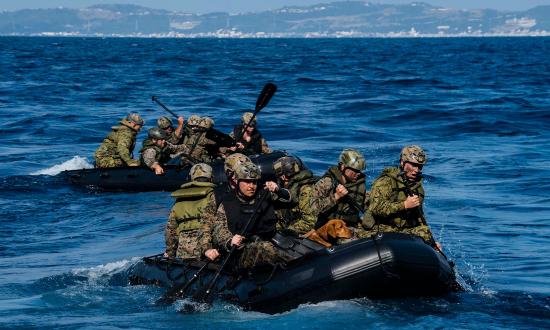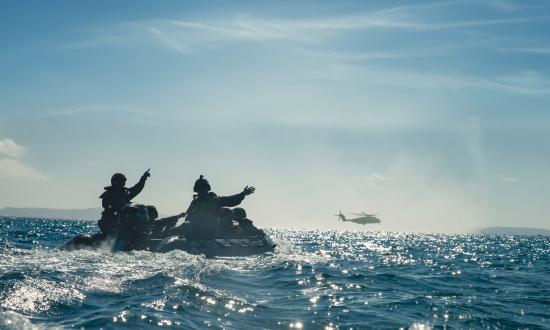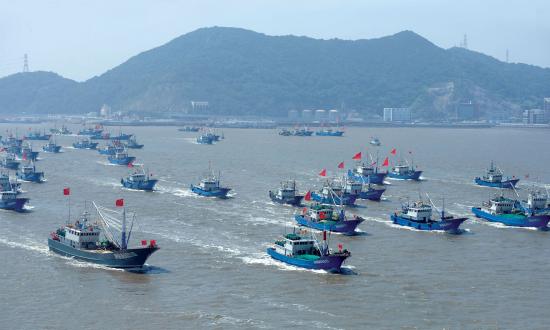Navy and Marine Corps efforts to prepare for the future fight have generated many ideas regarding operations in the most contested domains. These ideas are currently being explored and operationally implemented in units such as the littoral regiment, the reconnaissance and counterreconnaissance force, and the experimental infantry battalion. Less attention has been paid to operations in the gray zone of competition, despite the fact that intelligence collections, partner training, and presence during competition are vital to success if a conflict becomes violent.
To realize emerging concepts in Force Design 2030 and the 2020 triservice maritime strategy, Advantage at Sea, more attention is required on competition-focused Marine Corps contributions in the contact layer. The Marine Corps can rapidly establish a viable, sustainable, and experienced force capable of making significant contributions in this area with simple changes and by consolidating existing forces and concepts.
The Marine Corps should create a unit that would combine concepts from I Marine Expeditionary Force’s (MEF’s) all-domain reconnaissance (ADR) team and II MEF’s nascent all-domain effects team (ADET) and integrate them into an operational sensor-and-effector asset for fleet commanders. Integrating the ADR and the ADET concepts would create an all-source sensor/effector team that could provide commanders kinetic and nonkinetic targeting, opportunities, actions, and feedback.
A More Capable Combined Unit
The ADR team is a highly capable Marine expeditionary unit (MEU) intelligence-collection team that integrates collection enablers with a Marine reconnaissance company base unit. The ADR team already operates in West Coast MEUs. It can insert full-spectrum intelligence-collection assets, sensors, and effectors in the intermediate littoral area, operating between blue-water Navy and land-based operations. This fills a critical intelligence need for expeditionary advanced base operations. The ADET integrates various information-related capabilities in the MEF information group with an air–naval gunfire liaison company base unit. The ADET includes, but is not limited to, psychological operations, space operations, communications strategy, defensive cyber operations, civil affairs, and electronic warfare entities. Fusing the ADR team’s maneuver capacity with the ADET’s intelligence functions would provide commanders better ways to detect, understand, and counter an adversary’s plans for competition.
Combined ADET/ADR units would provide task force commanders options for sensing and providing a range of effects prior to conflict and at various physical distances. The sensor/effector teams should reside at the fleet command level to best facilitate integrated nonkinetic fires. ADET components would contribute to distant collection and nonkinetic effects, whereas the ADR and air–naval gunfire liaison aspect of these units would contribute to collection and facilitate kinetic fires if hostilities begin.
Sensor/effector teams created from existing Marine Corps capabilities would be able to influence adversary decision-making with a range of human and technology-based sensors. Intelligence analysis techniques, such as precoordinated target audience analysis, intelligence preparation of the battlespace, and operational preparation of the information environment, give the teams an understanding of the operational area and ways to affect it. Team capabilities, such as psychological operations, civil affairs, and electronic warfare, would quickly be able to create effects and feed the team’s intelligence assets. This process would slow the adversary’s cognitive response while enabling fleet commanders to make quicker decisions.
Sensor/effector teams would be capable of a range of military operations. For example, they would be able to conduct theater security cooperation events (namely, intelligence, reconnaissance, fires, and information operations–based events), provide baseline understanding of the informational and physical environment (route, area, zone, and beach/helicopter landing zone surveys), and liaise with host-nation forces to achieve unified nonkinetic effects before the beginning of hostilities.
Minimizing Effects on the MEU
The Marine Corps would have to mitigate the effects of sensor/effects teams on Marine expeditionary units’ maritime interdiction operations (MIO) capability. MEUs use reconnaissance companies as ADR base units for maritime interdiction because reconnaissance Marines are the only ones with the water survival and weaponeering skills such operations require. Sensor/effector teams would need to be decoupled from MIO and not be manned in
a way that detracts from the pool of individuals capable of filling MIO requirements. For example, the base unit of a sensor/effector team could be a reconnaissance platoon instead of a company, with the MEUs retaining other reconnaissance elements for MIO. Alternatively, MIO missions could be pushed to infantry units deploying with MEUs, provided they go through the appropriate certification exercises and training with Expeditionary Operations Training Group.
More important, command relationships would need to be carefully considered. One reason the current ADR and ADET models have not achieved more traction is because they are not well known in the Marine Corps. ADETs reside in MEF information groups. While this ties them into larger MEF objectives, unlike combatant commanders or joint task force commanders, MEF commanders do not have the authority to employ forces. ADR teams deploy as part of the MEU command elements. When deployed, MEU commanders can offer this force to combatant or joint task force commanders, but the transitory nature of MEUs makes employment highly dependent on commanders’ knowledge, comfort level, situation, and priorities. ADR teams and ADETs are not ideally placed in the hierarchy to be forces of choice, and highly capable units are therefore underused.
To optimize their potential to contribute, sensor/effector teams would need to deploy on a rotational basis to ensure continual coverage and work directly for Navy or Marine Corps commanders at the fleet or combatant-command level. This would mean working for a numbered fleet commander, joint force maritime component commander, or standing Marine-led task forces. This would be similar to how MEU personnel work with Task Force 51/5 in Central Command.
As a standing Marine command element entity, Task Force 51/5 can immediately understand, receive, and employ assigned Marine collection assets in a manner that supports the combatant commander. A colocated, multispectral, all-domain, and multiskilled expeditionary sensor/effects team at the combatant commander’s ready call would increase Navy–Marine Corps cooperation, consistent with the vision of the Chief of Naval Operations and Commandant of the Marine Corps.
Reorganizing, reinvesting, and consolidating Marine Corps skills can achieve significant change. This proposed model contributes to the conversation on how to create the ideal force for the future fight and will help Marines win wars before they begin.







